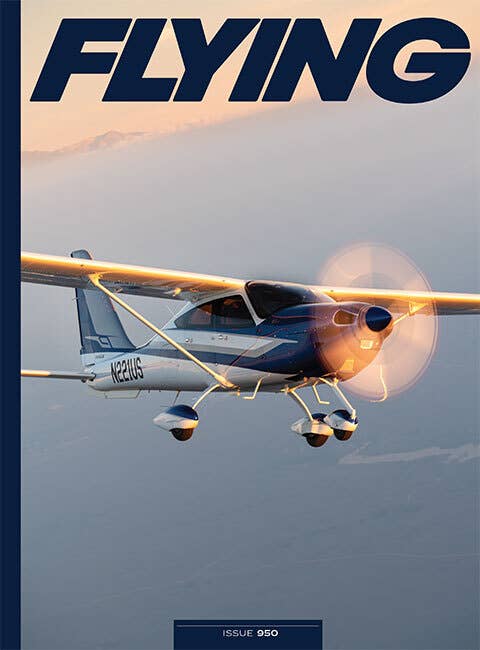“What is that guy doing?”
That guy was the pilot of a Cessna 172 doing right traffic for Runway 15 at a nontowered airport where the published traffic pattern was to the left. This was particularly alarming as there were three student pilots in the pattern already, and one of them was mine on his first solo. A quick call on the Common Traffic Advisory Frequency (CTAF) advised the C-172 in right traffic that this airport utilized left traffic.
If you’re not already a subscriber, what are you waiting for? Subscribe today to get the issue as soon as it is released in either Print or Digital formats.
The wrong-way pilot replied he didn’t know how to do left traffic and abruptly left the pattern. The airplane traced back to a flight school at a nearby airport that had a right traffic pattern for Runway 16. I wondered how he’d made it to solo and been signed off for other airports without knowing how to fly left traffic.
Diagram the Pattern
Traffic pattern departures and entries at all airports, especially first-time visits, can be anxiety producing. How many of you reading this have drawn the traffic pattern on your navlog before you embarked on a solo cross-country flight? We become used to flying at our home field and the visual cues the landmarks give us. There can be a “when-do-I-turn” moment? Address this by an objective study of the pattern.
Chapter 14 of the Pilot’s Handbook of Aeronautical Knowledge covers traffic patterns. I find it helpful if the learner reads this, then the instructor proceeds to draw a generic pattern on a whiteboard and have the learner copy the drawing onto a piece of paper. Note, I said copy, not take a picture of it, because the process of drawing and labeling it does more for the learning process than the passive act of photography. Instructor tip: Use multiple colors. One for the runway, another for the traffic pattern, another for the notation of the altitudes, headings, and distance from the runway, plus another for the power settings and aircraft configuration.

Learners can get hung up on what headings they will be on as they move around the pattern. Once established in the pattern, each turn will be in 90-degree increments.
You may find it useful to use the wind side of a mechanical E6-B to demonstrate this.
Place the heading of the departure runway (like 35) under the True Index. You don’t have to move the compass rose for this, so put the E6- B on the desk and don’t touch it, just look.
Note the direction of turns in the pattern, stressing that a standard traffic pattern is to the left. Taking off from Runway 350, the next turn is to crosswind, which is 90 degrees to the left of 350, aircraft on a heading of 260 (verify with look at E6-B). The turn to downwind puts the aircraft on a heading of 170 (the reciprocal of 350). The next turn (base) takes you to 080, and a turn on final brings you back to 350. It should be fairly easy for the learners to look at the heading indicator in the cockpit and “see” the heading for 90 degrees and verify it matches what they see out the windscreen.
Determining the distance from the runway can also be a challenge. For single-engine piston aircraft approximately 0.5-miles to 0.75-miles laterally from the runway on downwind is a good metric, but don’t fixate on the runway because this tends to make you fly into it. Get your spacing and locate something on the horizon to put the nose of the aircraft on—and keep your head on a swivel looking for traffic.
Pattern Altitude
Typical pattern altitude (TPA) is usually 1,000 feet agl. It may be lower due airspace constraints, so double-check the airport’s information in the chart supplement to be sure. Also look for noise abatement information, such as guidance on what altitude to make turns and power settings. Some airports have hard-copy pamphlets on this or put the information online. Note this information is advisory in nature, and safety always supercedes it.
Never drop the airplane to fly the radio. At a nontowered airport use the CTAF to announce your position and intentions, beginning and ending the radio call with the name of the airport as some frequencies are shared. Keep your transmissions concise and useful: “Podunk Airport, Cessna 123 midfield, downwind for Runway 17 for landing, Podunk.”
If you are flying a twin, say “twin Piper” or “twin Cessna” to let the other traffic know you are likely faster than the other traffic in the pattern. Communication is part of situational awareness, but not all aircraft have radios, and some pilots eschew their use if the airspace doesn’t require radio calls.
At a towered airport, when the tower is in operation, you do not need to self-announce turns unless the controller specifically asks you to, such as, “Cessna 1234, let me know when you are turning base.”
Arrivals
Approximately 10 miles out, listen to the weather and the CTAF to get an idea how busy it is and what runway is in use.
At towered airports, ATC tells you how to enter the pattern. At nontowered airports, the PHAK recommends, if appropriate, overflying the pattern at least 500 feet above pattern altitude. “When well clear of the pattern—approximately 2 miles—scan carefully for traffic, descend to pattern altitude, then turn right (if entering left traffic) to enter at 45-degrees to the downwind leg at midfield.”
An alternate technique sometimes used when the pilot approaches the airport from the opposite side of the
pattern has them entering on a midfield crosswind then executing a “teardrop” turn into the downwind. While there is nothing illegal about this, it is not one to be used at busy airports because it doesn’t give you much time to develop situational awareness, and a lack of this can result in a midair collision. I discourage their use. The same with straight-in approaches for the very same reason.
The term teardrop does not appear in FAA publications or reference materials for VFR approaches—it comes from tribal knowledge. The size of the teardrop varies from pilot to pilot, so it is suspect at best.
It is, however, an IFR hold entry, which can be confusing as noted in the FAA Advisory Circular AC90-66B that cautions against using IFR terminology in a VFR environment.
Published Visual Approaches
Some airports have VFR procedures that are published online or in hard copy that outline pattern entry and are customized to the airport. They often have anointed photographs of the approach with landmarks like railroad tracks, gravel pits, and the like called out along with altitudes the pilot should be flying and special notes like “note the Bravo that starts at the surface a mile north of the water towers.”
Departures
There are several options for departure from a nontowered airport. Chapter 4 of the AIM suggests departing at a 45-degree angle from the crosswind leg, although straight out and on the downwind are often used.
Care should be taken on the downwind to maintain pattern altitude until past the usual pattern boundary, because if you are climbing on the downwind, that puts you at risk for colliding with an aircraft over the airport at 500 feet above pattern altitude to maneuver for pattern entry.
Flying the pattern can be fun—and let’s keep it safe as well.
This column first appeared in the February Issue 955 of the FLYING print edition.
Credit: flyingmag.com











